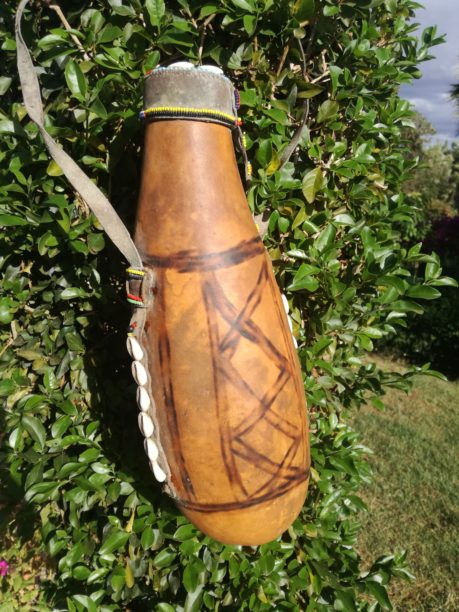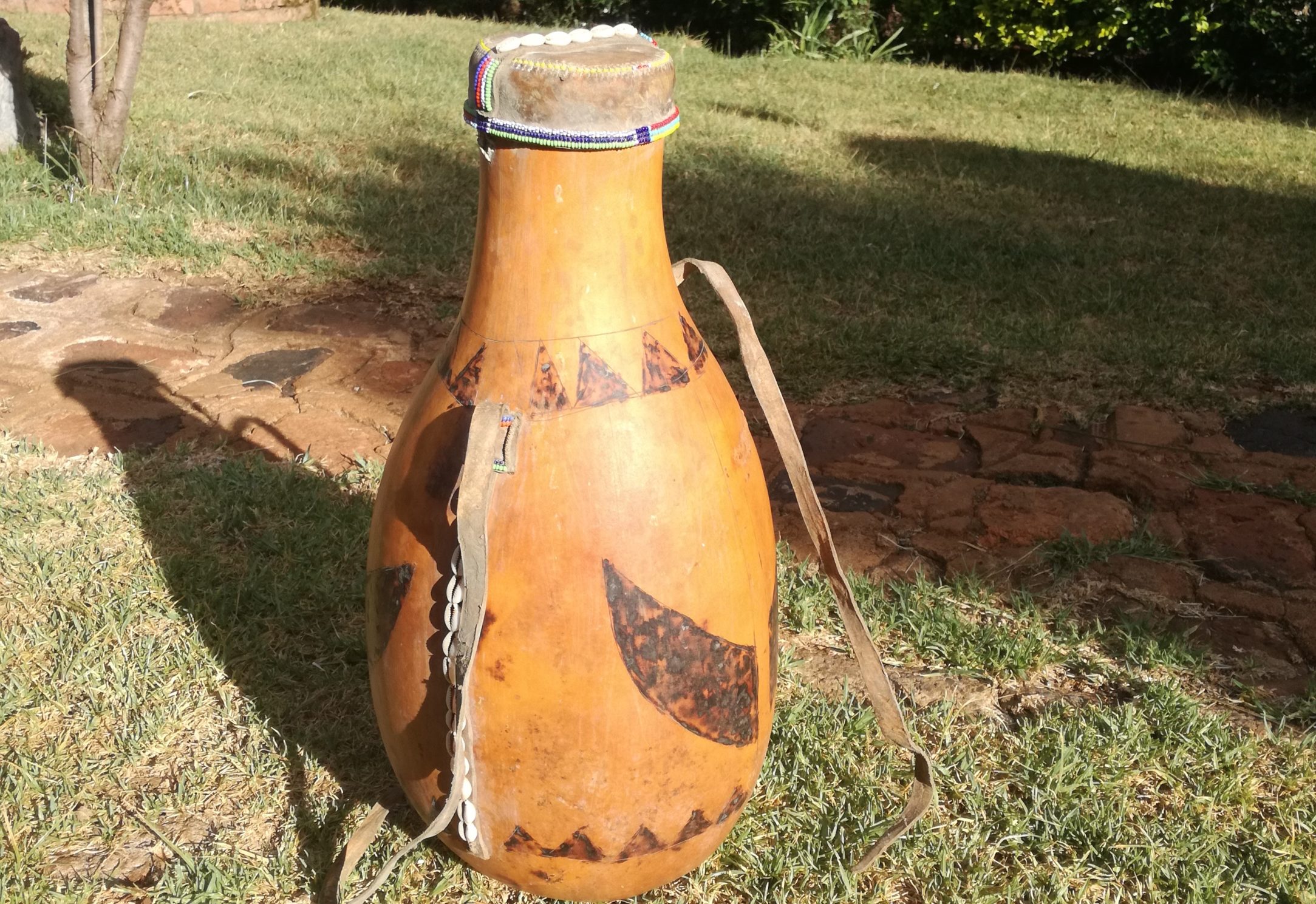We would wait six days for thick mursik.
On the first day, my mother would pour milk, which she had boiled and left to cool, inside the sotet. The milk would disappear inside the sotet’s charcoal-smeared depths, only being revealed when it was about to fill. She would seal the sotet with its beaded, leather cap and place it inside the lengut, the wooden structure that held all the sotonik in the house, and which was always placed in a cool, dark corner, fit for the bacteria and yeast to feed on the milk’s sugars. On the third day, the whey would have separated and my mother would pour it out, replacing the lost volume with more milk. If there was still a lot of whey on the following day, she would do it again. On the sixth day, the mursik, with all its blue-grey splendor, would have swelled up to the sotet’s funnel, wafting a strong, tangy scent; if the sotet was moved, it would produce a sound like a person stepping on mulch. After shaking the mursik into an even emulsion, my mother would pour it in our cups, so thick we would eat it with a spoon.

We had many sotonik in our lengut, each with its own personality. The smallest and my favorite was known as kiptambut. Our kiptambut was as round as he was tall, and looked like a pumpkin (aside from his thin neck which widened at the top). Kiptambut would hold just enough mursik to fill three cups, which often meant mursik just for one person. In most cases, that person was me. Generations back, a kiptambut full of mursik would have been presented to a warrior back from a cattle raid, a mother who had just had a child, a friend who had not been seen in years: mursik, a rich food, could restore cheer to the spirit and strength to the body. No other welcome could be as heartfelt.
The most artfully decorated sotonik are kipseger. We rarely used them to make mursik and instead hung them on the wall, tattoed round with fascinating shapes in the forms of tears and stars, their leather straps beaded intricately with tiny blue and yellow beads, and embedded, in regular intervals, with white cowrie shells. The sotet we valued the most stood higher than my waist. It was red in color and spare in decoration, and would swallow all the milk it was given and still have space for more. It would make enough mursik to feed the nine of us.
To clean the sotonik, my mother used the leaves of these three plants, motosyet, labotwet and ng’echepchat. The leaves of the motosyet were furry, and in Kapsio where we lived, it was often used as toilet paper. The labotwet had thorns and was difficult to pluck, though the shrub would yield bouncy, yellow berries for us to play with, and for old women to place on the arched shrines that stood before homesteads to ward off bad omens (shrines that were already beginning to be out-of-place by the time I was born). The ng’echepchat was medicinal; the ash from its leaves was used to cure all manner of ailments in both man and beast. With the aid of warm water, and a sosiot—this being the dried and trimmed branch of a palm tree—mother would scrub the inside of the sotet with the leaves till it was clean, suspend the sotet upside down on the sosiot, and lean it against a wall to dry. To prepare the sotet for making mursik, my mother would thrust an itet—which was the dry branch of a nerkwo, chemusarya, or a ketit tap ulaya tree—under hot ash until it glowed red, then break bits of the hot charcoal inside the sotet. She would use a curved stick, known as kipsumonei, to scrub the charcoal evenly on the sotet’s walls. When the sotet was ready, I would look inside and see nothing but a dark vortex that seemed to have no end, a universe of swirling black dust.
The verb sut is used to describe this act of lifting the kipsumonei up and down the sotet. As children, we didn’t know what its English equivalent was, so we would use it as an English verb. “Mother is suting the sotet,” we’d say; “Do you know how to sut a sotet?”
To sut the sotet, my mother would sit outside on the grass, place the sotet on her lap, where she would twirl it with her left hand, as her right hand lifted the kipsumonei in and out the sotet. It was an ancient dance that had repeated itself across generations and she would use the time to perform, telling us stories and becoming the people in the stories she told, ancestors long gone. She became my great-great grandfather Rumbas who sought employment among the pokot, herding cattle so that he could be repaid with calves: unable to wait for his dues, he thrust his employer through the heart with his spear and took his cattle back home; to confuse the spoor, he forced the cattle to follow buffalo tracks.
Then there was the story of my grandmother Kimoi, who passed on when I was just three. Her eldest son was a bit of a drifter and hardly ever home. One time he stayed for months and months without being seen and Kimoi wondered if he had gone to her co-wife’s homestead, which was about five kilometers away. She prepared mursik in a kiptambut and carried it for her visit, but the river Kipkaren, which she was meant to cross in order to reach her destination, was flooded. As she sat distraught, a man without a shadow approached her and told her that she would be able to cross, only if she kept her eyes on the bank on the other side and not on the water. This man asked her to give him the kiptambut, then held her hand and helped her cross. When Kimoi turned to thank him, he had disappeared, together with the kiptambut. When she reached her co-wife’s hut, she saw that a snail had drawn the sign of the cross on the door. That man, she would say, was Jesus.
Studies indicate that the ethanol and acetaldehyde produced by the mursik, as a result of the activities of the specific bacteria and yeast involved, are carcinogens that can trigger the development of cancer cells along the alimentary canal. My brother shared a link to such a research on our family WhatsApp group and we discussed it rather forlornly, split between our loyalty to the rigorousness and accuracy of scientific research, and our nostalgia about mursik. But the idea that it could bear death was unfathomable. This was what was given to a patient on hospital visits, with the belief that it would strengthen the body’s immunity. It was mursik which we all gathered to drink inside my cousin’s house, after his funeral, its sour taste clinging on our tongues, and for a moment providing the chance of another world that was not about tears and grief.
Keguro once asked where he could go and buy mursik, and I told him that there was difference between mursik that was made to be sold, and mursik that was made for a person you loved. Mursik made for a person you love is finite, just three cups-full, all in one kiptambut. Mursik for sale always has to be there, not meant to be finished. But if it is meant to be ever-flowing, what does that say about its production? Will a child still be sent into the bush to search for a motosyet and be fascinated by the spiders, ladybirds and flowers he will see as he plucks? Will it offer the same thrill, as it happens at a home, when rains fall and a cow gives birth, and a mother takes out the sotonik from the lengut and readies them for the milk? Is the mursik made for the person you love special since it involves waiting for it to be ready?
Mursik made for the person you love required patience. If there was no grass for the cows, you would have to wait for the rains to fall. If there was no milk, you would have to wait for the cow to give birth.
In the song Angandan Kororon Tukuchu Bo Chumbek (“Even if These Things By White People are Good”), sung by the legendary Kipchamba Arap Tabotok, who rose to the heights of his fame in the sixties and seventies, we are told “bottled milk is sweet but one in a sotet is marvelous. These traditional utensils make the best meals. Go now, and make a sotet and a pot!” He tells us that ugali served on a plate is sweet, but one served on a kisyet is the best, then instructs us to preserve the stephania when clearing land, for it is the vines of the stephania that are used to weave the kisyet. The end of the song fascinates me: “when you hit a pot it breaks, when you hit a bottle it breaks, and none will decompose in the soil.”
Kiprop Kimutai






